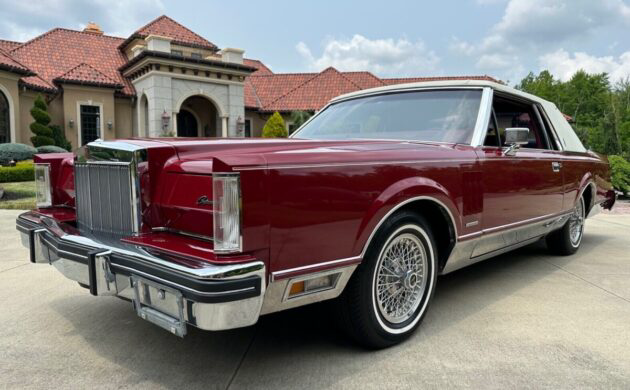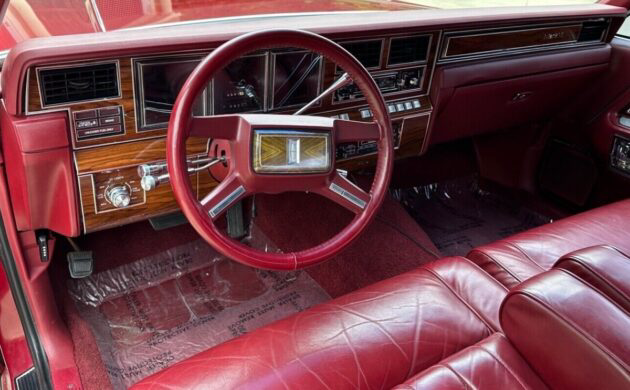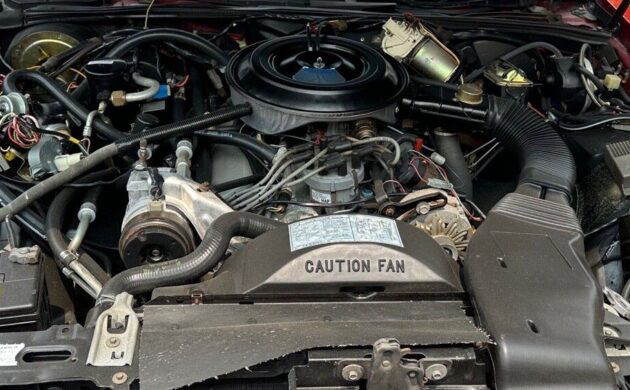To be as easy on the eyes and seemingly well-cared-for as this 1983 Lincoln Continental Mark VI here on eBay appears, it’s sort of surprising that the car’s traceable history only dates back a short 3 years. In fact, just about the only information we get about its past is that a family-owned dealership purchased the automobile back in 2020, but there’s no mention of whether or not they took the car in as a trade, bought it at auction, or any other hints about its whereabouts over the last four decades. On the other hand, the pictures sort of speak for themselves, and what they’re saying to me is this one sure looks like a fine example of one of the more elite personal luxury offerings of its day. It’s being offered for sale by Wally Armour CDJR in Alliance, Ohio, and is from the personal collection of one of the business owners. So far, bidding has reached $8,800, which is already enough to drive the car home as there’s no reserve.
The Lincoln is claimed to have only 19k original miles on the ticker, and while the seller offers no positive proof he does say to let the condition and cleanliness tell the story, and unless this car’s had a complete restoration I tend to believe him. It’s not stated as fact that the red paint is original, but factory or respray the finish seems to present beautifully overall, with just a few minor chips and dings here and there. The trim also appears to be nicely preserved, although this one’s also got that fake convertible material, not my favorite roof covering but you used to see quite a few of these running around back in the day and it seems to be in good shape, especially for being white.
On the contrary, there’s not much white at all to be found inside, if any. The interior is pretty much red everywhere you look, with a notable exception being the headliner. Apparently, it was sagging and this issue was addressed during the prime of Covid, and red wasn’t available so it was redone in black. All of the power components are stated to be working, such as the windows, seats, mirrors, door locks, and even the antenna, plus there has also been Bluetooth installed, which functions by tuning the radio of the Premium Sound System to 98.1 on the FM dial.
By 1983, a 302 was all that could be had for the powerplant, as the 351 was available only during the first year of Mark VI production in 1980, with the 400 and 460 gone since the days of the Mark V. The 5.0 only made 140 horsepower, but it was fuel injected and the automatic transmission had an overdrive feature which helped with better gas mileage on the highway. The seller says the Lincoln is fun to drive and suggests the one problem the next owner might want to immediately address is the A/C, which is not blowing cold at the moment. If a Mark VI is on your bucket list of cars to own at some point, this one seems like a decent candidate, and may even end up exchanging hands at a reasonable price. What are your thoughts on this Lincoln?





In 1985 an old roommate bought a 1980 Mark VI coupe from a couple who lived in Florida. It was the same burgundy/red color with a matching vinyl top, and leather interior. The only thing he needed to do was scrape the dark tint off the side windows. It turned some heads back then.
I saw figures of 130hp for a single exhaust, duals had 145hp. This beauty appears to have that setup. Ford blessed these coupes w good gears .. 3.08 std. 3.42, 3.55 opt.
I don’t hate this car’s roof treatment as much as I would’ve when I was a Car and Driver-reading teenager and this was a decade-old out-of-style used car I’d walk right past to go for something more “practical” (read; suited to slow-car-fast driving).
It’s still not my first choice – I suppose you have to have been of a generation that came of age before hardtops existed to think of a convertible uptop as being desirable and elegant rather than an ugly tent to be used only when strictly necessary – but in 2023 it has a whiff of “they don’t make ’em like that anymore”.
And this carries it off better than the firstgen Hyundai Excel I saw with one once, street parked back in the day!
I shuddered when these things came out. Like Lincoln was trying to fool their loyal customers. “Look folks! It’s just like the Mark V you bought in ’79…but, but, but..gas mileage!” These always looked odd to me.
I had an 81 Bill Blass. Beautiful dk blue/champagne that bordered on pimpy.
302 is not enough for entering freeways w/o having to push the pedal to the floor. With that said, I drove it cross-country in total comfort.
I was told the Mark VI had engine issues. Does anyone agree with what I was told?
Had not heard of that. Alliance Ohio? That’s about an hour from me. I’m tempted to take a look at it. I wonder if he’ll take my 1991 Mustang LX in trade?
Can’t speak for the Mark VI; but its contemporary, the non-Mark humpback Continental, had serious issues in its debut year of ’82, which I can speak of from experience. In that year, for inexplicable reasons, they fitted that engine (the fiver, which was actually optional for that model) with the dreadful variable-venturi carburetor which was one of two things that killed appeal for the Versailles. That carburetor made any issues the 4300s had seem trivial. In its last year, 1980, Versailles had TBI to replace the VV (too late to save the name, but still)…yet in ’82, after three years’ experience with TBI, they STILL put a VV on the Versailles’ replacement! When that carburetor failed, the whole dash display would go haywire, the engine would rattle like BBs in a coffee can with the slightest pressure of the pedal, and NOT ONE Ford center would touch it, not even for money. Their excuse: It was “obsolete.” That was what every dealer in the area told my grandmother, in 1985. At least the Mark VI engine had TBI from the start, as did the non-Mark humpback Continentals starting in ’83. To this day I cannot figure for the life of me why they re-applied such an unreliable component when better alternatives were already on-hand.
No one knows how to read these old odometers. This one has rolled over. It has over 119,000 miles. Also odometers can be rolled back or replaced. Nice car though!
1983 Lincoln Mark VI was the “ last big 2-door Lincoln “ built. End of an era. To me – this one is highly collectible for what it is. If you want a “ wide interior “, these Mark VI’s gave you the same and in some measurements even more room than a 1979 Mark V. Of course it didn’t have the “Rolls Royce “ weight and touring car feel – but it felt pretty close. I wish I could buy it – like now, but I can’t. 1983 was the year I graduated High school. I remember these brand new and thought – “ you know, they did a pretty good job with what they had “. Nice article!!
I’ve always liked the Mark Vl style. I think it’s a great looking car, and a good job of downsizing. My favorite “large Mark” is the 1974 through 1976 model years. I think they really carry that Lincolnesck look and presence. My parents owned a 76 Town Car 4 door in Dark Red Moondust Metallic, with half vinyl roof complete the coach lights in the B pillars. The interior was a maroon velour with thick carpet. It was powered by the 460 with 4 barrel Motorcraft carburetor. I could never justify owning such a huge car for myself. I almost bought a 1981 Mark Vl, it was dark blue with dark blue vinyl top over dark blue velour interior. I really liked the Mark Vl, they were very popular here in Southern California. I finally went for a 1990 black with black leather Mark Vll LSC, I couldn’t pass that one up. While still owning the Mark, I bought a black 1997 Explorer, Eddie Bauer, it became my daily driver, it was great looking Explorer by about that time we had 4 of them in the family. It had the Mustang 5.0 V8. I really liked that Explorer and drove the wheels off of it. It was very reliable. I only had to replace the A/C compressor in just under 200,000 miles. A great vehicle, great looking and great running. I always hoped to have a Mark Vl, but haven’t yet.
The 302 V8 during the Mark VI years was a good engine beside the fiberglass timing chain sprockets can go bad and the teeth break off. Also the EEC III computer fuel injection was at times troublesome and no Keep alive memory to permanently kept a code when the system intermittently act up, so it made it a lot harder for a mechanics at the time to determine what was the problem with the system until it actually was acting up.
The Continental died along with the 460 …